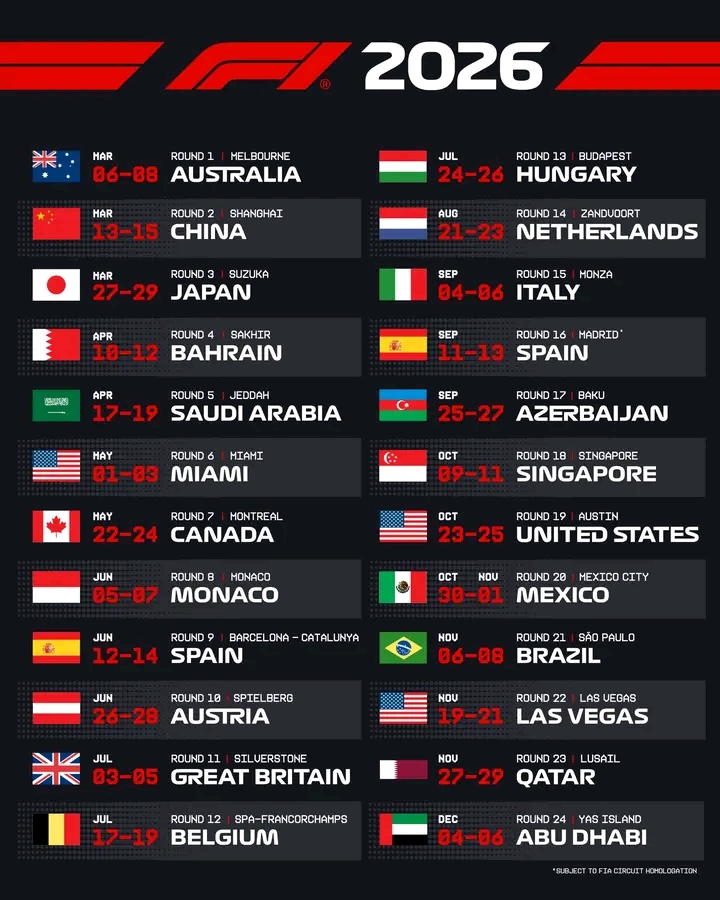The 2026 Formula 1 World Championship: A Global S…read more
The 2026 Formula 1 World Championship calendar has been released, promising a thrilling season of unprecedented global reach and technological innovation. With a record-breaking 24 races scheduled across five continents, the sport is poised to captivate a wider audience than ever before. The announcement, met with widespread excitement from fans and teams alike, details a diverse and demanding schedule designed to showcase the pinnacle of motorsport in some of the world’s most iconic and breathtaking locations.
The calendar kicks off in traditional fashion with the Bahrain Grand Prix, a night race under the desert stars that has become a staple of the modern F1 season. From there, the circus moves across the globe, encompassing established European circuits like Monaco, Silverstone, and Monza, each holding a special place in F1 history and promising electrifying races. These classic tracks, beloved by drivers and fans alike, will continue to be the stage for intense battles for position and strategic maneuvering.
However, 2026 also sees a significant expansion into new territories, reflecting F1’s ambition to become a truly global sport. The addition of several brand-new venues will bring the excitement of F1 to previously untapped markets, introducing the sport to a new generation of fans. While specific details remain under wraps pending final confirmations, sources suggest the inclusion of races in previously unexplored regions like South America and Africa, signaling a commitment to diversifying the sport’s geographic footprint and broadening its appeal. This expansion reflects not only a strategic move to capitalize on burgeoning markets but also a genuine desire to share the passion of F1 with a wider global community.
The inclusion of these new venues will, undoubtedly, present logistical challenges, but the teams are already preparing for the unique demands of each circuit. The variety of track layouts, ranging from high-speed straights to challenging corners, will require meticulous car setup and strategic adjustments throughout the season. Teams will need to carefully balance development resources across the diverse demands of the calendar, requiring meticulous planning and a commitment to adaptability. This expanded schedule also places greater emphasis on driver fitness and team management, demanding exceptional physical and mental endurance from all involved.
Beyond the geographic expansion, the 2026 season is also a pivotal year for technological advancements within the sport. The introduction of new power unit regulations, featuring a significant increase in sustainable energy deployment, signifies a commitment to environmental responsibility and a push towards more sustainable technologies. These changes will present a considerable engineering challenge for the teams, demanding innovative solutions and potentially reshaping the competitive landscape. This transition to more sustainable power units will not only lessen the environmental impact of the sport but also lead to intriguing developments in car design and performance, potentially ushering in a new era of F1 racing.
The 2026 calendar is more than just a list of races; it’s a testament to the enduring appeal of Formula 1 and its ambition to reach a global audience. It represents a strategic blend of tradition and innovation, balancing the legacy of iconic tracks with the excitement of new venues and groundbreaking technological advancements. The coming season promises a year of unprecedented drama, competition, and global reach, cementing Formula 1’s position as the pinnacle of motorsport and a truly captivating global spectacle. The 24 races across five continents will undoubtedly provide a season full of unforgettable moments, defining a new chapter in the rich history of Formula 1. The anticipation is palpable, and the countdown to the first race has begun.




